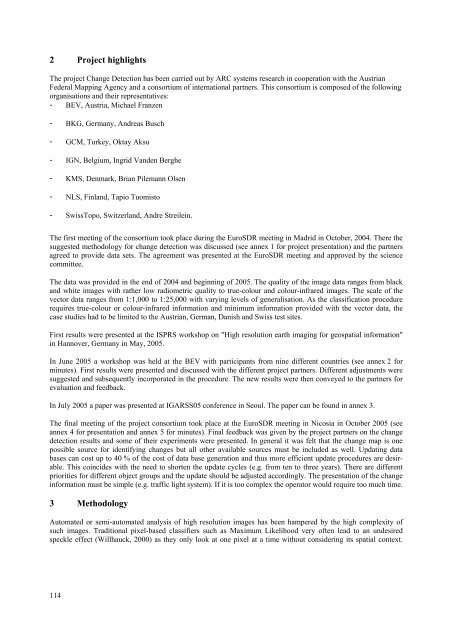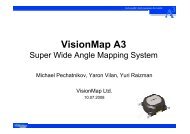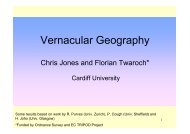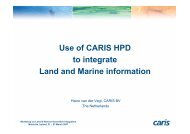EuroSDR Projects - Host Ireland
EuroSDR Projects - Host Ireland
EuroSDR Projects - Host Ireland
You also want an ePaper? Increase the reach of your titles
YUMPU automatically turns print PDFs into web optimized ePapers that Google loves.
2 Project highlights<br />
The project Change Detection has been carried out by ARC systems research in cooperation with the Austrian<br />
Federal Mapping Agency and a consortium of international partners. This consortium is composed of the following<br />
organisations and their representatives:<br />
- BEV, Austria, Michael Franzen<br />
- BKG, Germany, Andreas Busch<br />
- GCM, Turkey, Oktay Aksu<br />
- IGN, Belgium, Ingrid Vanden Berghe<br />
- KMS, Denmark, Brian Pilemann Olsen<br />
- NLS, Finland, Tapio Tuomisto<br />
- SwissTopo, Switzerland, Andre Streilein.<br />
The first meeting of the consortium took place during the <strong>EuroSDR</strong> meeting in Madrid in October, 2004. There the<br />
suggested methodology for change detection was discussed (see annex 1 for project presentation) and the partners<br />
agreed to provide data sets. The agreement was presented at the <strong>EuroSDR</strong> meeting and approved by the science<br />
committee.<br />
The data was provided in the end of 2004 and beginning of 2005. The quality of the image data ranges from black<br />
and white images with rather low radiometric quality to true-colour and colour-infrared images. The scale of the<br />
vector data ranges from 1:1,000 to 1:25,000 with varying levels of generalisation. As the classification procedure<br />
requires true-colour or colour-infrared information and minimum information provided with the vector data, the<br />
case studies had to be limited to the Austrian, German, Danish and Swiss test sites.<br />
First results were presented at the ISPRS workshop on "High resolution earth imaging for geospatial information"<br />
in Hannover, Germany in May, 2005.<br />
In June 2005 a workshop was held at the BEV with participants from nine different countries (see annex 2 for<br />
minutes). First results were presented and discussed with the different project partners. Different adjustments were<br />
suggested and subsequently incorporated in the procedure. The new results were then conveyed to the partners for<br />
evaluation and feedback.<br />
In July 2005 a paper was presented at IGARSS05 conference in Seoul. The paper can be found in annex 3.<br />
The final meeting of the project consortium took place at the <strong>EuroSDR</strong> meeting in Nicosia in October 2005 (see<br />
annex 4 for presentation and annex 5 for minutes). Final feedback was given by the project partners on the change<br />
detection results and some of their experiments were presented. In general it was felt that the change map is one<br />
possible source for identifying changes but all other available sources must be included as well. Updating data<br />
bases can cost up to 40 % of the cost of data base generation and thus more efficient update procedures are desirable.<br />
This coincides with the need to shorten the update cycles (e.g. from ten to three years). There are different<br />
priorities for different object groups and the update should be adjusted accordingly. The presentation of the change<br />
information must be simple (e.g. traffic light system). If it is too complex the operator would require too much time.<br />
3 Methodology<br />
Automated or semi-automated analysis of high resolution images has been hampered by the high complexity of<br />
such images. Traditional pixel-based classifiers such as Maximum Likelihood very often lead to an undesired<br />
speckle effect (Willhauck, 2000) as they only look at one pixel at a time without considering its spatial context.<br />
114









